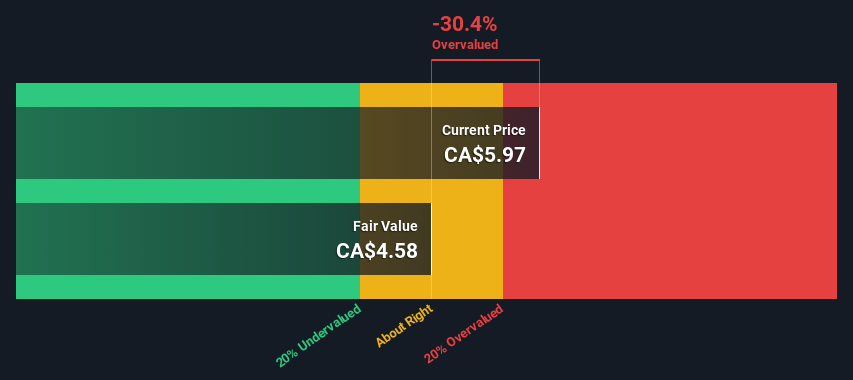- Canada
- /
- Oil and Gas
- /
- TSX:NXE
NexGen Energy Ltd.'s (TSE:NXE) Intrinsic Value Is Potentially 23% Below Its Share Price

Key Insights
- NexGen Energy's estimated fair value is CA$4.58 based on 2 Stage Free Cash Flow to Equity
- Current share price of CA$5.97 suggests NexGen Energy is potentially 30% overvalued
- Analyst price target for NXE is CA$9.88, which is 116% above our fair value estimate
Today we will run through one way of estimating the intrinsic value of NexGen Energy Ltd. (TSE:NXE) by taking the forecast future cash flows of the company and discounting them back to today's value. One way to achieve this is by employing the Discounted Cash Flow (DCF) model. Believe it or not, it's not too difficult to follow, as you'll see from our example!
Companies can be valued in a lot of ways, so we would point out that a DCF is not perfect for every situation. For those who are keen learners of equity analysis, the Simply Wall St analysis model here may be something of interest to you.
View our latest analysis for NexGen Energy
The Calculation
We're using the 2-stage growth model, which simply means we take in account two stages of company's growth. In the initial period the company may have a higher growth rate and the second stage is usually assumed to have a stable growth rate. To start off with, we need to estimate the next ten years of cash flows. Where possible we use analyst estimates, but when these aren't available we extrapolate the previous free cash flow (FCF) from the last estimate or reported value. We assume companies with shrinking free cash flow will slow their rate of shrinkage, and that companies with growing free cash flow will see their growth rate slow, over this period. We do this to reflect that growth tends to slow more in the early years than it does in later years.
A DCF is all about the idea that a dollar in the future is less valuable than a dollar today, so we need to discount the sum of these future cash flows to arrive at a present value estimate:
10-year free cash flow (FCF) estimate
| 2024 | 2025 | 2026 | 2027 | 2028 | 2029 | 2030 | 2031 | 2032 | 2033 | |
| Levered FCF (CA$, Millions) | -CA$201.7m | -CA$501.7m | -CA$478.0m | CA$166.5m | CA$206.4m | CA$242.2m | CA$272.9m | CA$298.6m | CA$319.9m | CA$337.6m |
| Growth Rate Estimate Source | Analyst x3 | Analyst x3 | Analyst x3 | Analyst x2 | Est @ 23.99% | Est @ 17.33% | Est @ 12.67% | Est @ 9.41% | Est @ 7.13% | Est @ 5.53% |
| Present Value (CA$, Millions) Discounted @ 8.6% | -CA$186 | -CA$425 | -CA$373 | CA$120 | CA$137 | CA$148 | CA$153 | CA$154 | CA$152 | CA$148 |
("Est" = FCF growth rate estimated by Simply Wall St)
Present Value of 10-year Cash Flow (PVCF) = CA$28m
We now need to calculate the Terminal Value, which accounts for all the future cash flows after this ten year period. The Gordon Growth formula is used to calculate Terminal Value at a future annual growth rate equal to the 5-year average of the 10-year government bond yield of 1.8%. We discount the terminal cash flows to today's value at a cost of equity of 8.6%.
Terminal Value (TV)= FCF2033 × (1 + g) ÷ (r – g) = CA$338m× (1 + 1.8%) ÷ (8.6%– 1.8%) = CA$5.1b
Present Value of Terminal Value (PVTV)= TV / (1 + r)10= CA$5.1b÷ ( 1 + 8.6%)10= CA$2.2b
The total value, or equity value, is then the sum of the present value of the future cash flows, which in this case is CA$2.2b. To get the intrinsic value per share, we divide this by the total number of shares outstanding. Compared to the current share price of CA$6.0, the company appears reasonably expensive at the time of writing. Remember though, that this is just an approximate valuation, and like any complex formula - garbage in, garbage out.

Important Assumptions
The calculation above is very dependent on two assumptions. The first is the discount rate and the other is the cash flows. You don't have to agree with these inputs, I recommend redoing the calculations yourself and playing with them. The DCF also does not consider the possible cyclicality of an industry, or a company's future capital requirements, so it does not give a full picture of a company's potential performance. Given that we are looking at NexGen Energy as potential shareholders, the cost of equity is used as the discount rate, rather than the cost of capital (or weighted average cost of capital, WACC) which accounts for debt. In this calculation we've used 8.6%, which is based on a levered beta of 1.143. Beta is a measure of a stock's volatility, compared to the market as a whole. We get our beta from the industry average beta of globally comparable companies, with an imposed limit between 0.8 and 2.0, which is a reasonable range for a stable business.
SWOT Analysis for NexGen Energy
- Debt is well covered by earnings.
- Current share price is above our estimate of fair value.
- Shareholders have been diluted in the past year.
- Significant insider buying over the past 3 months.
- Debt is not well covered by operating cash flow.
- Has less than 3 years of cash runway based on current free cash flow.
- Not expected to become profitable over the next 3 years.
Looking Ahead:
Whilst important, the DCF calculation is only one of many factors that you need to assess for a company. DCF models are not the be-all and end-all of investment valuation. Preferably you'd apply different cases and assumptions and see how they would impact the company's valuation. For example, changes in the company's cost of equity or the risk free rate can significantly impact the valuation. Can we work out why the company is trading at a premium to intrinsic value? For NexGen Energy, we've put together three important items you should look at:
- Risks: Every company has them, and we've spotted 4 warning signs for NexGen Energy (of which 2 can't be ignored!) you should know about.
- Future Earnings: How does NXE's growth rate compare to its peers and the wider market? Dig deeper into the analyst consensus number for the upcoming years by interacting with our free analyst growth expectation chart.
- Other Solid Businesses: Low debt, high returns on equity and good past performance are fundamental to a strong business. Why not explore our interactive list of stocks with solid business fundamentals to see if there are other companies you may not have considered!
PS. The Simply Wall St app conducts a discounted cash flow valuation for every stock on the TSX every day. If you want to find the calculation for other stocks just search here.
Valuation is complex, but we're here to simplify it.
Discover if NexGen Energy might be undervalued or overvalued with our detailed analysis, featuring fair value estimates, potential risks, dividends, insider trades, and its financial condition.
Access Free AnalysisHave feedback on this article? Concerned about the content? Get in touch with us directly. Alternatively, email editorial-team (at) simplywallst.com.
This article by Simply Wall St is general in nature. We provide commentary based on historical data and analyst forecasts only using an unbiased methodology and our articles are not intended to be financial advice. It does not constitute a recommendation to buy or sell any stock, and does not take account of your objectives, or your financial situation. We aim to bring you long-term focused analysis driven by fundamental data. Note that our analysis may not factor in the latest price-sensitive company announcements or qualitative material. Simply Wall St has no position in any stocks mentioned.
About TSX:NXE
NexGen Energy
An exploration and development stage company, engages in the acquisition, exploration, evaluation, and development of uranium properties in Canada.
Excellent balance sheet low.
Similar Companies
Market Insights
Community Narratives


